Answered step by step
Verified Expert Solution
Question
1 Approved Answer
(Dont Use Java JUST ) ! (Dont Use Java JUST ) ! (Dont Use Java JUST ) ! (please please please please please don't use
(Dont Use Java JUST ) !
(Dont Use Java JUST ) !
(Dont Use Java JUST ) !
(please please please please please don't use GPT)
(please please please please please don't use GPT)
(please please please please please don't use GPT)
(use data structure algorithm C Language) !
(use data structure algorithm C Language) !
(use data structure algorithm C Language) !
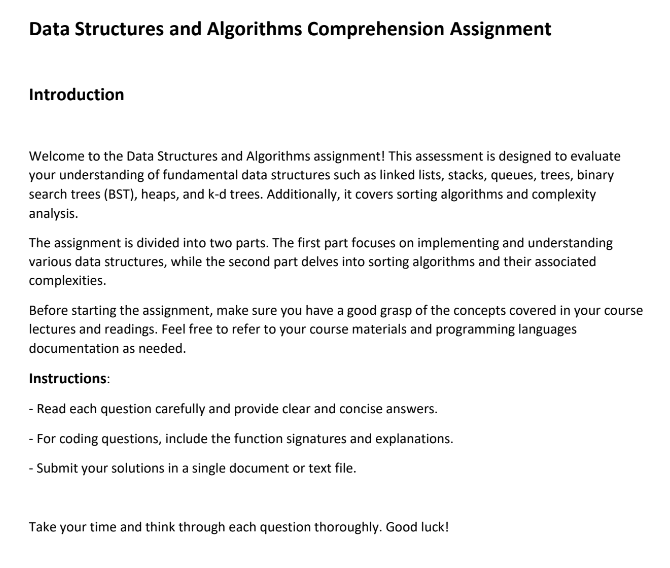
d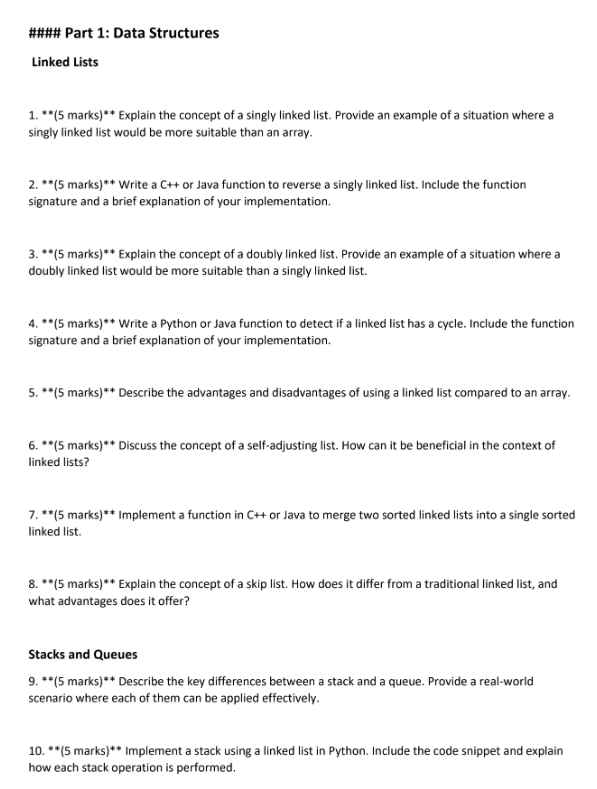
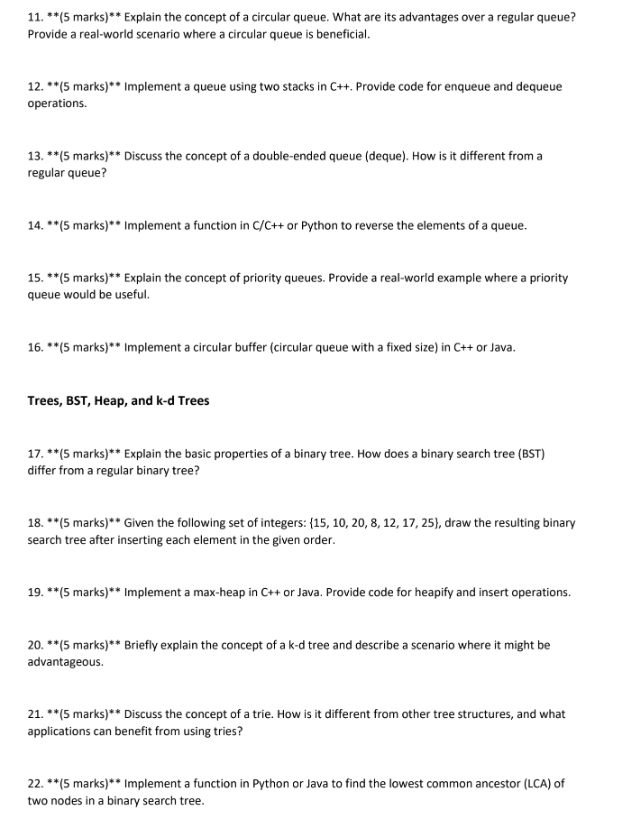
d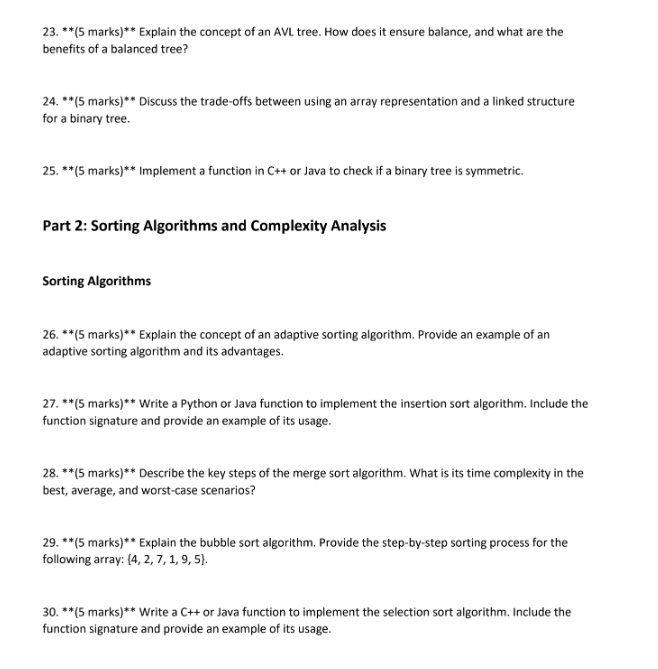
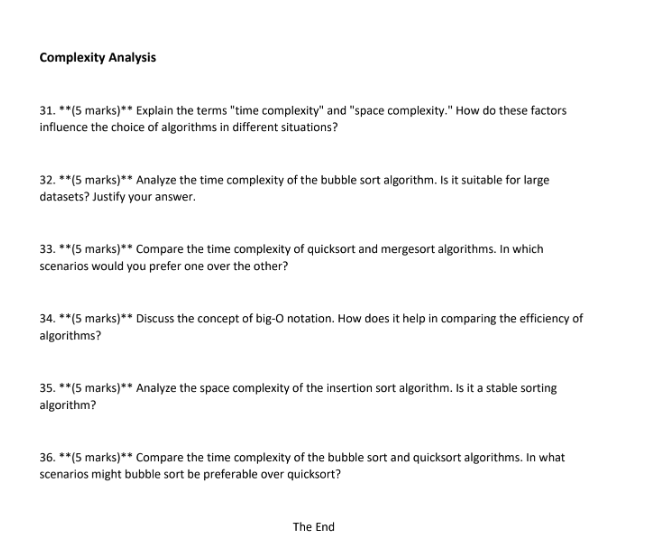 Data Structures and Algorithms Comprehension Assignment Introduction Welcome to the Data Structures and Algorithms assignment! This assessment is designed to evaluate your understanding of fundamental data structures such as linked lists, stacks, queues, trees, binary search trees (BST), heaps, and k-d trees. Additionally, it covers sorting algorithms and complexity analysis. The assignment is divided into two parts. The first part focuses on implementing and understanding various data structures, while the second part delves into sorting algorithms and their associated complexities. Before starting the assignment, make sure you have a good grasp of the concepts covered in your course lectures and readings. Feel free to refer to your course materials and programming languages documentation as needed. Instructions: - Read each question carefully and provide clear and concise answers. - For coding questions, include the function signatures and explanations. - Submit your solutions in a single document or text file. Take your time and think through each question thoroughly. Good luck! Linked Lists 1. (5marks) Explain the concept of a singly linked list. Provide an example of a situation where a singly linked list would be more suitable than an array. 2. **(5 marks)** Write a C++ or Java function to reverse a singly linked list. Include the function signature and a brief explanation of your implementation. 3. (5marks) Explain the concept of a doubly linked list. Provide an example of a situation where a doubly linked list would be more suitable than a singly linked list. 4. **(5 marks)** Write a Python or Java function to detect if a linked list has a cycle. Include the function signature and a brief explanation of your implementation. 5. **(5 marks ) Describe the advantages and disadvantages of using a linked list compared to an array. 6. (5marks) Discuss the concept of a self-adjusting list. How can it be beneficial in the context of linked lists? 7. **(5 marks)** Implement a function in C++ or Java to merge two sorted linked lists into a single sorted linked list. 8. **(5 marks)** Explain the concept of a skip list. How does it differ from a traditional linked list, and what advantages does it offer? Stacks and Queues 9. (5marks) Describe the key differences between a stack and a queue. Provide a real-world scenario where each of them can be applied effectively. 10. (5marks) Implement a stack using a linked list in Python. Include the code snippet and explain how each stack operation is performed. 11. **(5 marks)** Explain the concept of a circular queue. What are its advantages over a regular queue? Provide a real-world scenario where a circular queue is beneficial. 12. **(5 marks)** Implement a queue using two stacks in C++. Provide code for enqueue and dequeue operations. 13. **(5 marks)** Discuss the concept of a double-ended queue (deque). How is it different from a regular queue? 14. **(5 marks)** Implement a function in C/C++ or Python to reverse the elements of a queue. 15. **(5 marks)** Explain the concept of priority queues. Provide a real-world example where a priority queue would be useful. 16. **(5 marks)** Implement a circular buffer (circular queue with a fixed size) in C++ or Java. Trees, BST, Heap, and k-d Trees 17. **(5 marks)** Explain the basic properties of a binary tree. How does a binary search tree (BST) differ from a regular binary tree? 18. (5marks) Given the following set of integers: {15,10,20,8,12,17,25}, draw the resulting binary search tree after inserting each element in the given order. 19. **(5 marks)** Implement a max-heap in C++ or Java. Provide code for heapify and insert operations. 20. **( 5 marks)** Briefly explain the concept of a k - d tree and describe a scenario where it might be advantageous. 21. **(5 marks)** Discuss the concept of a trie. How is it different from other tree structures, and what applications can benefit from using tries? 22. **(5 marks)** Implement a function in Python or Java to find the lowest common ancestor (LCA) of two nodes in a binary search tree. 23. **(5 marks)** Explain the concept of an AVL tree. How does it ensure balance, and what are the benefits of a balanced tree? 24. **(5 marks)** Discuss the trade-offs between using an array representation and a linked structure for a binary tree. 25. **(5 marks)** Implement a function in C++ or Java to check if a binary tree is symmetric. Part 2: Sorting Algorithms and Complexity Analysis Sorting Algorithms 26. (5marks) Explain the concept of an adaptive sorting algorithm. Provide an example of an adaptive sorting algorithm and its advantages. 27. **(5 marks)** Write a Python or Java function to implement the insertion sort algorithm. Include the function signature and provide an example of its usage. 28. **(5 marks)** Describe the key steps of the merge sort algorithm. What is its time complexity in the best, average, and worst-case scenarios? 29. **(5 marks)** Explain the bubble sort algorithm. Provide the step-by-step sorting process for the following array: {4,2,7,1,9,5}. 30. **(5 marks)** Write a C++ or Java function to implement the selection sort algorithm. Include the function signature and provide an example of its usage. 31. **(5 marks)** Explain the terms "time complexity" and "space complexity." How do these factors influence the choice of algorithms in different situations? 32. **(5 marks)** Analyze the time complexity of the bubble sort algorithm. Is it suitable for large datasets? Justify your answer. 33. **(5 marks)** Compare the time complexity of quicksort and mergesort algorithms. In which scenarios would you prefer one over the other? 34. (5marks) Discuss the concept of big-O notation. How does it help in comparing the efficiency of algorithms? 35. **(5 marks)** Analyze the space complexity of the insertion sort algorithm. Is it a stable sorting algorithm? 36. (5marks) Compare the time complexity of the bubble sort and quicksort algorithms. In what scenarios might bubble sort be preferable over quicksort
Data Structures and Algorithms Comprehension Assignment Introduction Welcome to the Data Structures and Algorithms assignment! This assessment is designed to evaluate your understanding of fundamental data structures such as linked lists, stacks, queues, trees, binary search trees (BST), heaps, and k-d trees. Additionally, it covers sorting algorithms and complexity analysis. The assignment is divided into two parts. The first part focuses on implementing and understanding various data structures, while the second part delves into sorting algorithms and their associated complexities. Before starting the assignment, make sure you have a good grasp of the concepts covered in your course lectures and readings. Feel free to refer to your course materials and programming languages documentation as needed. Instructions: - Read each question carefully and provide clear and concise answers. - For coding questions, include the function signatures and explanations. - Submit your solutions in a single document or text file. Take your time and think through each question thoroughly. Good luck! Linked Lists 1. (5marks) Explain the concept of a singly linked list. Provide an example of a situation where a singly linked list would be more suitable than an array. 2. **(5 marks)** Write a C++ or Java function to reverse a singly linked list. Include the function signature and a brief explanation of your implementation. 3. (5marks) Explain the concept of a doubly linked list. Provide an example of a situation where a doubly linked list would be more suitable than a singly linked list. 4. **(5 marks)** Write a Python or Java function to detect if a linked list has a cycle. Include the function signature and a brief explanation of your implementation. 5. **(5 marks ) Describe the advantages and disadvantages of using a linked list compared to an array. 6. (5marks) Discuss the concept of a self-adjusting list. How can it be beneficial in the context of linked lists? 7. **(5 marks)** Implement a function in C++ or Java to merge two sorted linked lists into a single sorted linked list. 8. **(5 marks)** Explain the concept of a skip list. How does it differ from a traditional linked list, and what advantages does it offer? Stacks and Queues 9. (5marks) Describe the key differences between a stack and a queue. Provide a real-world scenario where each of them can be applied effectively. 10. (5marks) Implement a stack using a linked list in Python. Include the code snippet and explain how each stack operation is performed. 11. **(5 marks)** Explain the concept of a circular queue. What are its advantages over a regular queue? Provide a real-world scenario where a circular queue is beneficial. 12. **(5 marks)** Implement a queue using two stacks in C++. Provide code for enqueue and dequeue operations. 13. **(5 marks)** Discuss the concept of a double-ended queue (deque). How is it different from a regular queue? 14. **(5 marks)** Implement a function in C/C++ or Python to reverse the elements of a queue. 15. **(5 marks)** Explain the concept of priority queues. Provide a real-world example where a priority queue would be useful. 16. **(5 marks)** Implement a circular buffer (circular queue with a fixed size) in C++ or Java. Trees, BST, Heap, and k-d Trees 17. **(5 marks)** Explain the basic properties of a binary tree. How does a binary search tree (BST) differ from a regular binary tree? 18. (5marks) Given the following set of integers: {15,10,20,8,12,17,25}, draw the resulting binary search tree after inserting each element in the given order. 19. **(5 marks)** Implement a max-heap in C++ or Java. Provide code for heapify and insert operations. 20. **( 5 marks)** Briefly explain the concept of a k - d tree and describe a scenario where it might be advantageous. 21. **(5 marks)** Discuss the concept of a trie. How is it different from other tree structures, and what applications can benefit from using tries? 22. **(5 marks)** Implement a function in Python or Java to find the lowest common ancestor (LCA) of two nodes in a binary search tree. 23. **(5 marks)** Explain the concept of an AVL tree. How does it ensure balance, and what are the benefits of a balanced tree? 24. **(5 marks)** Discuss the trade-offs between using an array representation and a linked structure for a binary tree. 25. **(5 marks)** Implement a function in C++ or Java to check if a binary tree is symmetric. Part 2: Sorting Algorithms and Complexity Analysis Sorting Algorithms 26. (5marks) Explain the concept of an adaptive sorting algorithm. Provide an example of an adaptive sorting algorithm and its advantages. 27. **(5 marks)** Write a Python or Java function to implement the insertion sort algorithm. Include the function signature and provide an example of its usage. 28. **(5 marks)** Describe the key steps of the merge sort algorithm. What is its time complexity in the best, average, and worst-case scenarios? 29. **(5 marks)** Explain the bubble sort algorithm. Provide the step-by-step sorting process for the following array: {4,2,7,1,9,5}. 30. **(5 marks)** Write a C++ or Java function to implement the selection sort algorithm. Include the function signature and provide an example of its usage. 31. **(5 marks)** Explain the terms "time complexity" and "space complexity." How do these factors influence the choice of algorithms in different situations? 32. **(5 marks)** Analyze the time complexity of the bubble sort algorithm. Is it suitable for large datasets? Justify your answer. 33. **(5 marks)** Compare the time complexity of quicksort and mergesort algorithms. In which scenarios would you prefer one over the other? 34. (5marks) Discuss the concept of big-O notation. How does it help in comparing the efficiency of algorithms? 35. **(5 marks)** Analyze the space complexity of the insertion sort algorithm. Is it a stable sorting algorithm? 36. (5marks) Compare the time complexity of the bubble sort and quicksort algorithms. In what scenarios might bubble sort be preferable over quicksort Step by Step Solution
There are 3 Steps involved in it
Step: 1

Get Instant Access to Expert-Tailored Solutions
See step-by-step solutions with expert insights and AI powered tools for academic success
Step: 2

Step: 3

Ace Your Homework with AI
Get the answers you need in no time with our AI-driven, step-by-step assistance
Get Started


